Kayak Surfing (Learn, Get Started, Pro Tips)
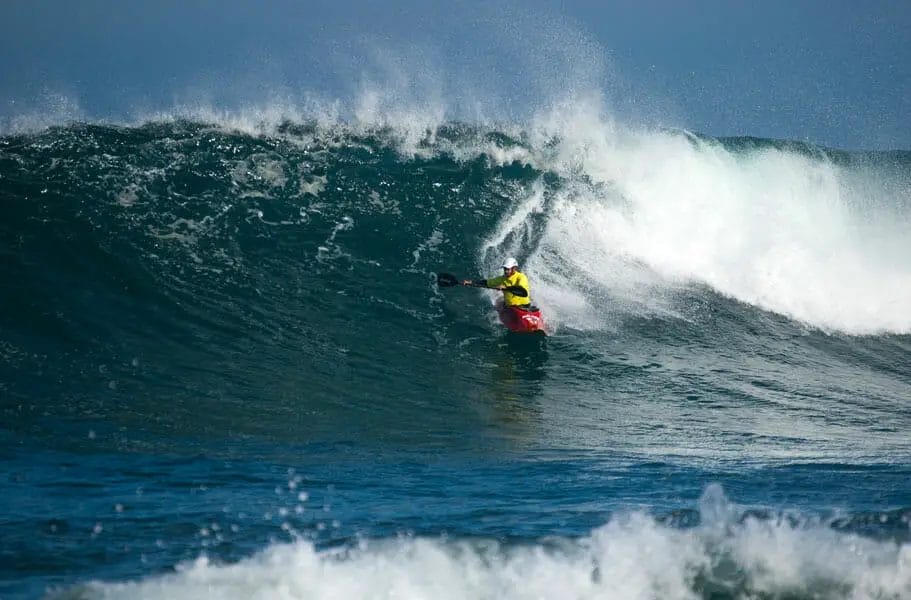
If you think the only kind of surfing you can do is on a board or with your body, think again. Kayak surfing is one of the fastest-growing wave sports on the ocean and rivers.
Whether you’re ripping a wave on an ice-cold river in British Columbia or catching a 10-foot breaker off the coast of South Africa, kayak surfing’s a blast and can add spice and variety to your paddling repertoire.
As you might imagine, surf kayaking has unique challenges and requires skills that the typical paddler may not possess.
For example, most sea kayakers are trained to launch their boat and get out over the swells into the open water, not how to ride back into the waves as a separate form of paddling entertainment. And most whitewater paddlers are trained on how to navigate down a stretch of river, not how to tackle a rolling breaker.

Brief History
The history of kayak surfing is intertwined with the origins of the kayak itself. The kayak is an ancient form of transportation developed by the Inuit, Yup’ik, and Aleut peoples of the Arctic regions of North America over a thousand years ago. These people used the kayak primarily for hunting and fishing in lakes, rivers, and coastal waters.
The evolution of the kayak into a vehicle for surfing is less defined, but the application of the kayak to wave riding has been traced back several hundred years. For instance, the Inuit people were known to have played games that involved riding waves in their kayaks for fun, much like modern kayak surfing.
In more recent history, the popularization of kayak surfing has followed a similar path to that of whitewater kayaking, becoming more prevalent as the designs of kayaks evolved in the 20th century.
Kayaks became more specialized, allowing for the high maneuverability required in surfing conditions.
Kayak surfing as a recognized sport started to take off in the late 20th century, particularly in the 1980s and 1990s, with the advent of the shorter, more maneuverable, and more durable plastic kayaks.
Whitewater vs Sea Kayak Surfing
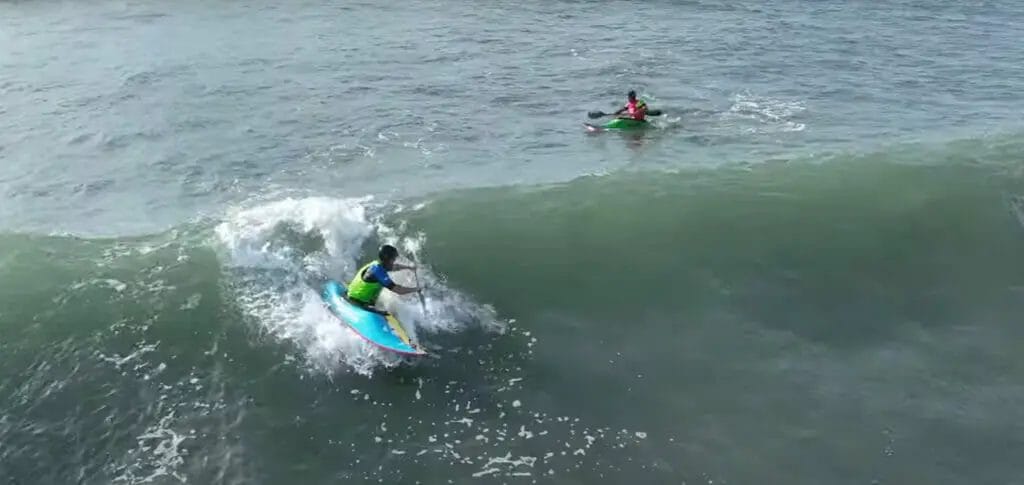
Whitewater Kayak Surfing: This kayak surfing is typically performed on river features such as standing waves and holes. The whitewater kayaks used are designed to be highly maneuverable, allowing the kayaker to perform various tricks. They are typically shorter and have a planing hull to facilitate surfing.
Sea Kayak Surfing: This type of kayak surfing is performed in the ocean or sea and involves riding breaking waves similar to those sought by surfers. Sea kayaks can be longer and narrower, designed for speed and tracking in open waters. However, specialized surf kayaks are also used, which are shorter and have flatter hulls for better performance on breaking waves.
Each variety offers a unique set of challenges and requires a slightly different skill set, although the fundamental principles of balance, control, and wave understanding apply to both.
Basic Requirements – Physical Fitness, Swimming Ability, etc.

Physical Fitness: Kayak surfing is a physically demanding sport requiring strong upper body strength to paddle and control the kayak. Core strength is also vital for maintaining balance on the waves. Regular cardio workouts can help build stamina, as kayaking can be tiring, especially when dealing with strong currents.
Swimming Ability: As the sport involves water and the risk of capsizing, being a strong swimmer is essential. Kayakers should be comfortable in the water and capable of handling themselves if they capsize or get thrown from their kayak.
Essential Equipment and Gear
Kayak: A specialized surf kayak, typically shorter and more maneuverable, is needed. It should have the durability to withstand the powerful forces of the waves.
Paddle: A double-bladed paddle is used in kayak surfing. Paddles come in different sizes and materials, so choosing one that suits your size and strength is crucial.
Wetsuit: Depending on the temperature of the water, a wetsuit might be necessary to prevent hypothermia.
Helmet and PFD (Personal Flotation Device): Safety gear like a helmet and a PFD are a must for protection and flotation.
Spray skirt: A spray skirt prevents water from entering the kayak.
The Right Kind of Kayak for Surfing
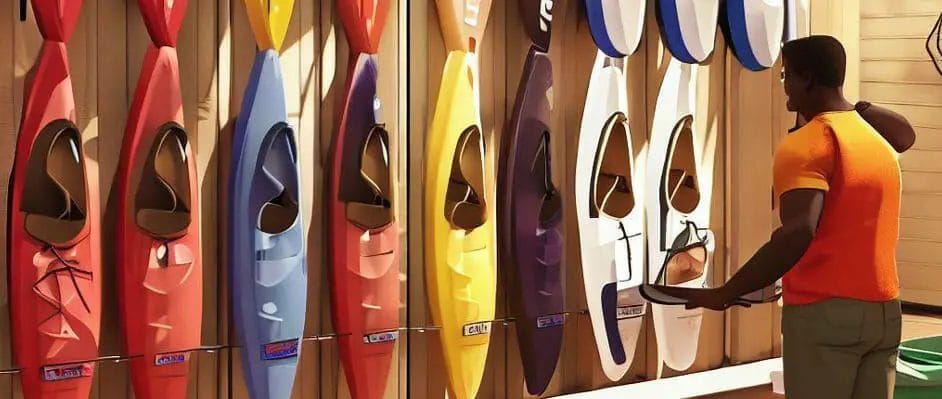
Surf kayaks are specifically designed for riding waves and are typically shorter and more maneuverable than touring kayaks. They come in various styles, including high-performance surf kayaks, typically made out of composite materials, and sit-on-top surf kayaks, which beginners often prefer for their stability and ease of exit.
Safety Gear – Helmets, PFD, etc.
Helmets: To protect against potential head injuries from capsizing or collision with the kayak, wearing a helmet is essential.
PFD (Personal Flotation Device): A PFD is crucial for keeping the kayaker afloat if they capsize. It should be well-fitted and comfortable to allow for easy movement.
Leash: A leash connects the kayaker to their kayak, preventing it from getting lost if they capsize.
Other safety gear: Depending on the location and conditions, other safety equipment like a whistle, a knife (for cutting the leash if necessary), a first aid kit, and a VHF radio for emergencies might also be recommended.
Choosing the Right Location – Factors to Consider

Choosing the right kayak surfing location is crucial for your enjoyment and safety. Here are some factors to consider:
- Wave Conditions: The wave conditions are perhaps the most critical aspect. For beginners, smaller, more predictable waves are ideal. As one gains confidence and skill, they can move on to larger, more challenging waves.
- Tides: Understanding the tidal conditions is critical. Some locations are best at high tide, while others are better at low tide. Knowing the tidal behavior can help you avoid potential hazards and make the most of your surfing session.
- Currents: The strength and direction of currents can significantly impact your surfing. Strong currents can make it difficult to control the kayak and increase the risk of accidents.
- Wind: The wind can influence wave size, direction, and your ability to control the kayak. Onshore winds can make the waves choppy and harder to surf, while offshore winds can make the waves cleaner and easier to navigate.
- Accessibility: Consider how easy it is to get to the location and get in and out of the water. Remember that you’ll carry a kayak, so easy access is important.
- Safety: Check for hazards like rocks, reefs, or strong rip currents. Also, consider the availability of lifeguards or rescue services, especially if you’re new to the sport or the area.
- Local Regulations and Respect: Check local regulations about water activities, as some beaches might not allow kayak surfing. Respecting local surf etiquette is important, especially in areas shared with traditional surfers or swimmers.
- Crowds: Crowded areas can make it harder to catch waves and increase the risk of collisions. Finding a less crowded spot may be more enjoyable and safer, especially while learning.
Remember, safety should always be your top priority when choosing a location for kayak surfing. If you’re unsure about a location, it’s always a good idea to seek advice from local kayak surfers or clubs.
Learn Kayak Surfing
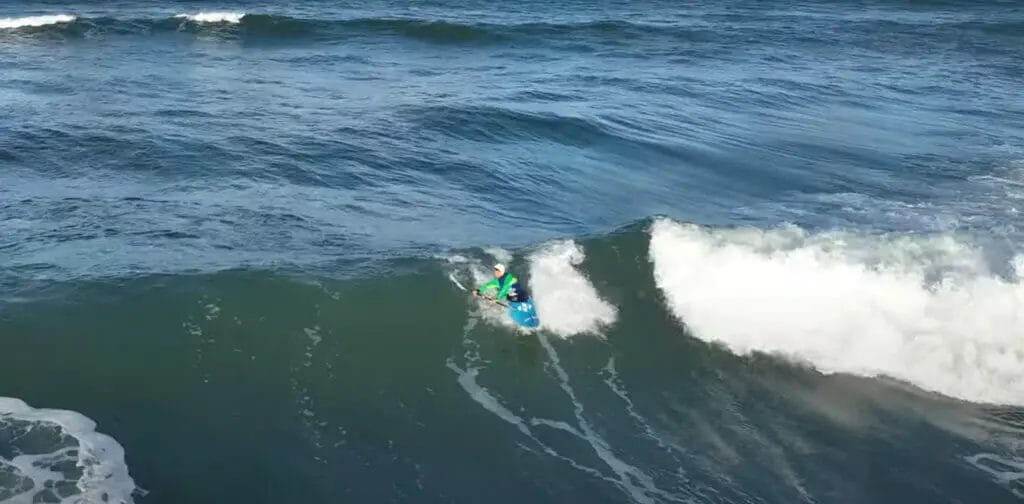
Learning kayak surfing involves understanding the basics of kayaking, reading and understanding wave dynamics, and developing your balance and control of the water.
It’s recommended to start with flatwater kayaking to get comfortable with the kayak and paddle. Once you’ve mastered the basics, you can take a kayak surfing class or hire an instructor to help you transition to the surf.
Practicing in small, gentle waves is a good way to start before gradually moving to larger waves as your skills and confidence grow.
Step-by-Step Guide to Kayak Surfing for Beginners
Step 1: Learn Basic Kayaking Skills – Start by learning how to paddle, steer, and control a kayak on flat water.
Step 2: Choose the Right Equipment – Get a suitable surf kayak, a double-bladed paddle, and the necessary safety gear, including a helmet and PFD.
Step 3: Learn to Roll – This is a crucial skill in kayak surfing. A roll lets you right yourself if you capsize without exiting the kayak.
Step 4: Learn About Waves – Understand how waves break and how to read wave patterns. This will help you know where and when to paddle to catch a wave.
Step 5: Practice – Start surfing small waves, gradually progressing to larger ones as you get comfortable.
Common Beginner Mistakes and How to Avoid Them
Mistake 1: Paddling Straight Out – This often leads to capsizing in the breaking waves. Instead, try paddling out at an angle to reduce the impact of the waves.
Mistake 2: Misjudging Waves – This can lead to missing waves or getting caught in powerful ones. Spending time to observe and understand wave patterns can help avoid this.
Mistake 3: Not Knowing How to Roll – Knowing how to roll is crucial for safety. Make sure to learn and practice this skill before hitting the waves.
Mistake 4: Ignoring Safety Gear – Always wear a helmet, PFD, and use a leash. These can save your life in case of a mishap.
Safety Tips While Learning

Tip 1: Always wear your safety gear, including a helmet, PFD, and leash.
Tip 2: Never Surf Alone – Especially when you’re learning, have a buddy with you, or make sure other people are around.
Tip 3: Learn to Roll – This key safety skill in kayak surfing enables you to right the kayak if you capsize.
Tip 4: Know Your Limits – Don’t try to surf waves that are beyond your skill level. Start with small waves and gradually progress to larger ones as your skill improves.
Tip 5: Check Weather and Tidal Conditions – Check the weather forecast and tidal conditions before heading out. Avoid going out in adverse weather or when strong currents are predicted.
Tips to Improve Your Kayak Surfing Skills

Practice Regularly: Like any sport, regular practice will significantly improve your kayak surfing skills. Make a habit of getting out on the water frequently.
Paddle Skills: Improve your paddle techniques, including different types of strokes and braces. This will provide you with better control over the kayak.
Watch and Learn: Watch experienced kayak surfers pick up on their techniques. If possible, seek their advice.
Rolling: Practice your roll technique until it becomes second nature. It’s an essential skill for staying safe and minimizing downtime after a wipeout.
Advanced Techniques for Better Control
Edge Control: Learn how to use your kayak’s edges to carve into waves and maneuver effectively.
Eskimo Roll: Master the Eskimo roll, a maneuver that enables you to right your kayak after capsizing without exiting.
Wave Timing: Learn how to use the power of the wave to your advantage, timing your moves to match the wave’s rhythm.
How to Read Waves and Weather Conditions

Understanding Waves:
Types of Waves
The first thing to understand is that not all waves are the same. In general, waves can be classified into three types:
- Spilling Waves: These are the most gentle type of waves, ideal for beginners. They break gradually, with the crest tumbling down the face of the wave.
- Dumping Waves: These waves break more violently, with the crest crashing onto the wave’s trough. They are more challenging to surf and require better timing and control.
- Surging Waves: These waves don’t truly break, but rather surge upon the shore. They’re less common for surfing but can still offer a ride in certain circumstances.
How Waves Break
Waves break when the depth of the water is approximately 1.3 times the wave’s height. When this happens, the wave crest becomes unstable and falls forward, creating the white frothy water characteristic of breaking waves. The way waves break is primarily influenced by the shape and gradient of the seafloor, known as “bathymetry.”
Reading Waves
- Watch the Horizon: You can often see the sets of waves approaching by observing the horizon line. Waves often come in sets, separated by calmer periods. Identifying these sets can help you predict when the next wave will come.
- Identify the Peak: The peak is the first part of the wave to break. Identifying the peak can help you correctly position yourself on the wave and maximize your ride.
- Observe the Direction: Waves don’t always come straight in towards the beach. They can also approach at an angle, known as a “left” or “right,” depending on your perspective facing the shore. Understanding this can help you position yourself better and anticipate the wave’s movement.
Wave Forecasting
Apart from observing waves in real time, you can also use wave forecasts to predict wave conditions. These forecasts use data from weather models and buoys to predict wave height, period (time between waves), and direction. Websites and apps like Magicseaweed, Surfline, or Windy provide such information.
Wave Size: Bigger waves are not always better for kayak surfing. It’s important to match the wave size to your skill level.
Weather Reports: Use weather and surf reports to understand what conditions to expect. With time, you’ll learn to interpret these reports and how they translate to real-world conditions on your local surf break.
Pro Tips for Kayak Surfing
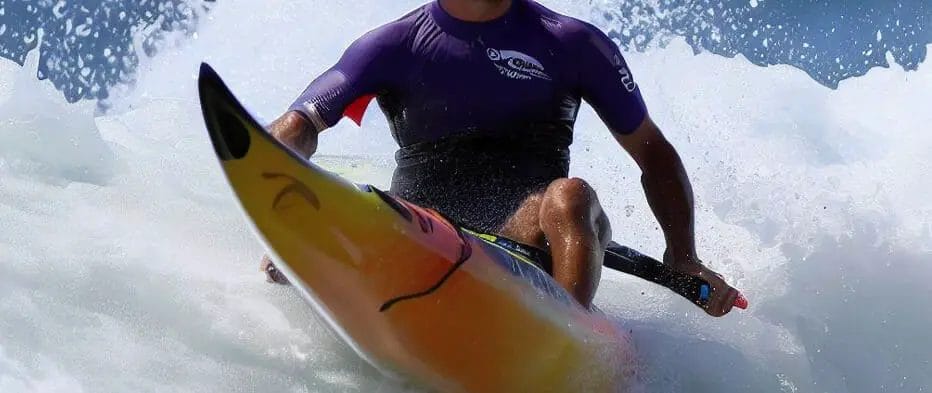
Stay Loose: Relax your body to absorb the motion of the waves better. This allows for more fluid movement and better control.
Stay Low: Lowering your center of gravity can give you more stability, especially when carving turns or riding down the face of a wave.
Keep waves from breaking on top of you when you can: There’s nothing worse than getting hammered by tons of frothing water and pinned against a sandbar, only to have another wave blast you seconds later. If you see that a wave’s about to break right on top of you, turn to paddle over it, or point your boat directly into the wave and right straight through it. Eventually you’ll get out past the break where the waves are a lot easier to deal with.
Plan your line of attack: Once you’re out past the break, the real fun begins. There are two ways you can ride a swell – either at an angle, or straight in toward shore. As you feel the swell building beneath you, start paddling in the direction of shore, at a speed that keeps you even with the wave. If you decide to surf at an angle, keep the bow of the kayak up and away from the direction the wave is breaking. If you point the bow down toward the wave, you run the risk of having a steep wave roll you over.
Eyes on the Horizon: Keep your eyes on the horizon, not your paddle or the water directly in front of you. This gives you a better view of incoming waves.
Know Your Limits: Recognize your current skill level and stay within it. Progress gradually, and don’t try to ride waves beyond your capability.
Strategies for Tackling Bigger Waves
Timing: Timing your entry into a big wave is crucial. Too early or too late, and you’ll likely wipe out.
The angle of Approach: Approach the wave at an angle instead of head-on. This helps spread out the force of the wave, making it easier to manage.
Paddle Hard: You need more momentum to catch bigger waves, so paddle hard as the wave approaches.
Techniques for Efficient Paddling
Use Your Torso: Rather than just your arms, use your whole torso to paddle. This not only gives you more power but also conserves energy.
Keep Paddles Close: Keep your paddle strokes close to the kayak. Wide strokes can waste energy and cause you to veer off course.
Paddle in a Straight Line: Paddle in a straight line as much as possible. Zigzagging or paddling in an S shape is less efficient and wastes energy.
Frequently Asked Questions (FAQ)
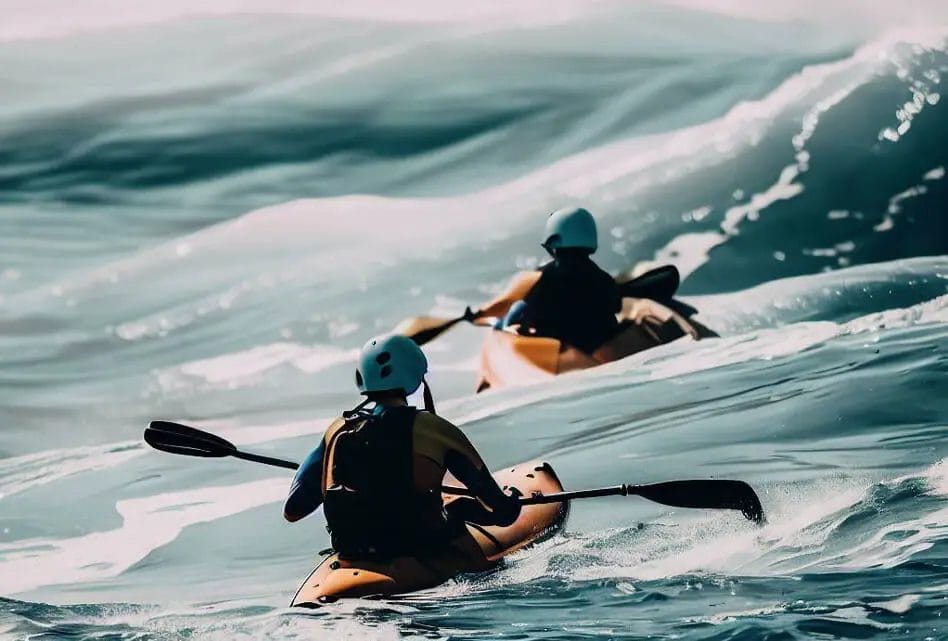
- Do I need to be a good swimmer to start kayak surfing? While you don’t have to be an Olympic swimmer, a decent level of swimming proficiency is necessary for safety reasons. You should be comfortable in the water and capable of swimming a reasonable distance, as you may have to swim in case of a capsize.
- Do I need to know how to surf before I try kayak surfing? You don’t need to know how to surf to try kayak surfing. While there are similarities, the skills are quite different. Basic kayaking skills are more important when starting.
- Is it dangerous to kayak surf? Like any water sport, kayak surfing has an element of risk. However, the risks can be minimized with proper training, equipment, and a good understanding of the water and weather conditions.
Common Questions Beginners Have
- What kind of kayak do I need for surfing? Surf kayaks are best for kayak surfing. They are typically shorter and more maneuverable than touring or recreational kayaks. There are also different designs for whitewater and sea surfing.
- How can I practice if I live far from the ocean? You can start by practicing paddling and control skills on a calm lake or river. Some whitewater parks also have standing waves where you can practice surf techniques.
- Can I surf big waves as a beginner? It’s best to start with smaller waves and gradually progress as your skills and confidence grow. Big waves can be dangerous for beginners.
Misconceptions About the Sport
- Misconception: Kayak surfing is easier than traditional surfing. Fact: While the sports have similarities, each presents unique challenges. Kayak surfing requires mastery of a kayak and a paddle and understanding how a kayak interacts with the waves.
- Misconception: Kayak surfers can’t “ride the tube” like surfers. Fact: Experienced kayak surfers can get barreled in the right conditions, although it’s a high-level skill requiring a powerful, hollow wave.
- Misconception: You don’t need to be fit to kayak surf. Fact: Kayak surfing requires a fair amount of strength and endurance, especially in the upper body. Good cardiovascular fitness is also important, as paddling can be strenuous.
Resources for Further Learning
Books:
“The Art of Surf Kayaking” by Bill Mattos: An excellent book that covers all aspects of surf kayaking, including equipment, techniques, and safety.
Links to Popular Kayak Surfing Forums and Communities
- Surf Kayak Forum on Boatertalk: This is a very active forum where people discuss various aspects of surf kayaking, share advice, and exchange tips.
Conclusion
Encouragement for Beginners to Try Out the Sport
For beginners considering taking up kayak surfing, it’s important to remember that everyone starts somewhere.
It might initially seem intimidating, but with proper instruction, practice, and patience, you can quickly progress and start catching waves.
As with any sport, the initial learning phase might be challenging, but the sense of achievement and the thrill of riding a wave makes it all worthwhile.
